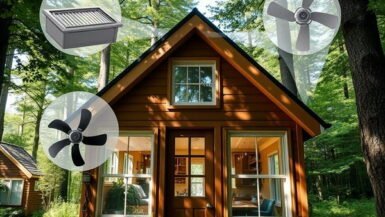As the trend of embracing minimalism and eco-friendly living continues to gain momentum, sustainable tiny homes have emerged as a popular choice for those seeking a simpler and greener lifestyle. One of the core aspects of a truly sustainable tiny home lies in the efficient management of its heating and cooling systems, which can significantly impact the overall carbon footprint and energy consumption. In this article, we delve into the intricacies of designing and implementing a sustainable heating and cooling system for your tiny abode, covering aspects such as insulation, energy-efficient technology, and the use of renewable energy sources. By integrating these elements in your tiny home’s design, you can create a comfortable living space while minimizing your environmental impact and long-term energy costs.
Energy-Efficient Insulation Techniques for Tiny Homes
To create a sustainable heating and cooling system in your tiny home, it is crucial to focus on insulation. Proper insulation not only maintains a comfortable temperature inside the house but also reduces energy consumption and lowers utility bills. In this section, we explore various energy-efficient insulation techniques that can help you build a well-insulated and eco-friendly tiny home.
The Importance of High R-Value Insulation Materials
When selecting insulation materials for your tiny home, it’s essential to pay attention to the R-value, which measures the material’s resistance to heat flow. A higher R-value indicates better insulation properties, ensuring that your home remains warm during winters and cool during summers. Some examples of high R-value insulation materials include spray foam, rigid foam boards, and cellulose insulation. These materials offer excellent thermal performance and are ideal for tiny homes with limited space.
Sealing Air Leaks and Gaps
In addition to choosing the right insulation materials, it’s essential to ensure that your tiny home is properly sealed to prevent drafts and air leaks. Areas around windows, doors, and other openings are often prone to air infiltration, which can significantly impact the efficiency of your heating and cooling system. To address this issue, use weatherstripping, caulking, and foam sealants to seal any gaps and improve the overall energy performance of your tiny house.
Insulating Windows and Doors
Windows and doors are often the weakest link in a home’s insulation system, as they can allow a significant amount of heat transfer. To minimize this effect, consider installing energy-efficient windows and doors with double or triple glazing, low-E coatings, and insulated frames. Additionally, you can use thermal curtains or window films to further enhance the insulation properties and reduce heat loss or gain through the windows.
Optimizing Insulation for Different Climate Zones
Depending on your location and climate, the insulation requirements for your tiny home may vary. For instance, homes in colder climates may need thicker insulation materials and higher R-values to maintain a comfortable temperature, while those in warmer regions may require lighter insulation and a focus on proper ventilation. To ensure the best results, consult local building codes or a qualified professional to determine the optimal insulation strategy for your specific climate zone.
By implementing these energy-efficient insulation techniques in your tiny home, you can create a comfortable living environment while minimizing your energy consumption and carbon footprint. With proper insulation and attention to detail, your tiny house can become a shining example of sustainable living.
Top Solar-Powered Heating Solutions for Small Spaces
Embracing solar energy is an effective way to create a sustainable heating and cooling system in your tiny home. The sun’s abundant energy is a renewable resource that can be harnessed to generate heat, power appliances, and even produce hot water. In this section, we explore various solar-powered heating solutions that are suitable for small spaces, offering cost-effective and environmentally friendly alternatives to traditional heating methods.
Solar Air Heaters
Solar air heaters are a simple yet effective way to warm your tiny home using the sun’s energy. These systems work by capturing sunlight and converting it into heat, which is then circulated throughout your living space. Solar air heaters come in various designs, including window-mounted units and standalone collectors, making them an adaptable solution for different tiny home layouts. Besides being energy-efficient, solar air heaters require minimal maintenance and can be easily installed by homeowners.
Passive Solar Design
Incorporating passive solar design principles into your tiny home’s architecture can significantly enhance its heating capabilities. This approach involves using building materials and design features to capture, store, and distribute solar heat naturally. For instance, installing south-facing windows and using thermal mass materials, such as concrete or stone, can help retain and radiate heat throughout your tiny home. This strategy not only improves your home’s energy efficiency but also reduces your reliance on external heating sources.
Solar Water Heating Systems
Solar water heating systems can provide an eco-friendly solution for supplying hot water in your tiny home. These systems utilize solar collectors to absorb sunlight and heat water, which can then be stored in a tank for later use. Solar water heating systems come in various configurations, including direct circulation systems and indirect circulation systems, catering to different climate conditions and household needs. By integrating a solar water heating system into your tiny home, you can significantly reduce your energy consumption and lower your carbon footprint.
Combining Solar Power with Energy-Efficient Appliances
Pairing solar energy with energy-efficient appliances can further optimize your tiny home’s heating and cooling system. Installing a solar photovoltaic (PV) system allows you to generate electricity from sunlight, which can then power devices such as energy-efficient space heaters, air conditioners, and heat pumps. Additionally, using smart home technology to monitor and control your appliances can help you manage your energy usage more effectively, ensuring that your tiny home remains comfortable and sustainable.
By exploring these solar-powered heating solutions and tailoring them to your specific needs, you can create a sustainable and energy-efficient heating system for your tiny home. Harnessing the power of the sun not only reduces your environmental impact but also offers long-term cost savings, making it a worthwhile investment for tiny home dwellers.
Compact and Eco-Friendly Cooling Systems for Tiny Houses
Creating a sustainable heating and cooling system in a tiny home requires a focus on energy efficiency, environmental impact, and space optimization. In this section, we will explore various compact and eco-friendly cooling systems that are perfect for tiny houses, ensuring that your living space remains comfortable during warm weather without compromising on sustainability and minimalism.
Energy-Efficient Air Conditioners
When it comes to cooling your tiny home, choosing an energy-efficient air conditioner is crucial for reducing energy consumption and minimizing your environmental footprint. Look for models with a high Seasonal Energy Efficiency Ratio (SEER) rating, which indicates better cooling performance with less energy usage. Additionally, opt for air conditioners with programmable thermostats and energy-saving modes, allowing you to maintain a comfortable temperature while conserving energy.
Ductless Mini-Split Systems
Ductless mini-split systems are an ideal cooling solution for tiny homes, as they offer high energy efficiency and require minimal installation space. These systems consist of an outdoor compressor and an indoor air-handling unit, connected by a small conduit. This setup eliminates the need for bulky ductwork and allows for precise temperature control in different zones of your home. Furthermore, many mini-split systems come with heat pump functionality, providing both heating and cooling capabilities in a single unit.
Evaporative Coolers
For those living in dry climates, evaporative coolers (also known as swamp coolers) can be an energy-efficient and eco-friendly alternative to traditional air conditioners. These coolers work by drawing hot air through moist pads, using the process of evaporation to cool the air before circulating it throughout your living space. Evaporative coolers consume significantly less energy compared to conventional air conditioners and add humidity to the air, making them an attractive option for arid regions.
Natural Cooling Strategies
Incorporating natural cooling strategies into your tiny home’s design can significantly reduce your reliance on energy-intensive cooling systems. Some effective techniques include:
– Utilizing cross-ventilation by strategically placing windows and vents to promote air circulation.
– Installing reflective roofing materials or green roofs to minimize heat absorption.
– Incorporating shading devices, such as awnings and pergolas, to block direct sunlight from entering your home.
– Planting trees and vegetation around your tiny house to provide natural shade and a cooler microclimate.
By combining these natural cooling strategies with compact and eco-friendly cooling systems, you can achieve a comfortable and sustainable living environment in your tiny home.
With the right approach and the integration of the solutions mentioned above, your tiny house can offer an ideal living space that stays cool during the warmer months while minimizing energy consumption and environmental impact. Embracing these compact and eco-friendly cooling systems will not only enhance your tiny home’s sustainability but also contribute to a greener and more energy-efficient future.
Harnessing Natural Ventilation in Your Tiny Home Design
Creating a sustainable heating and cooling system in a tiny home involves more than just energy-efficient appliances and insulation. One crucial aspect of maintaining a comfortable living environment while minimizing energy consumption is natural ventilation. By incorporating clever design techniques, you can harness the power of wind and air circulation to regulate your tiny home’s temperature without relying on energy-intensive cooling systems. In this subsection, we explore various strategies to optimize natural ventilation in your tiny home design, ensuring that your living space remains comfortable and eco-friendly.
Strategic Window and Vent Placement
The placement of windows and vents plays a significant role in promoting natural ventilation within your tiny home. To maximize air circulation, consider installing windows on opposite sides of your living space, allowing for cross-ventilation. This arrangement encourages the movement of fresh air through your home, replacing warm, stale air with cooler outdoor air. Additionally, placing vents high up on walls or in the ceiling can help release hot air that rises naturally, further enhancing the ventilation process.
Optimizing Window Size and Type
The size and type of windows you choose for your tiny home can also impact natural ventilation. Larger windows facilitate greater airflow, while smaller windows are more suited for targeted ventilation in specific areas of your home. Furthermore, selecting windows that can open fully, such as casement or awning windows, can significantly improve air circulation compared to sliding or fixed windows.
Utilizing Stack Effect and Solar Chimneys
The stack effect, or the natural movement of warm air upwards, can be harnessed to promote natural ventilation in your tiny home. By incorporating a solar chimney or a well-placed vent at the top of your living space, you can create a continuous flow of fresh air as warm air rises and exits through the chimney or vent. This design feature not only improves air quality but also contributes to passive cooling, reducing the need for energy-intensive air conditioning.
Integrating Operable Skylights and Roof Vents
Incorporating operable skylights and roof vents in your tiny home design can further enhance natural ventilation. These features offer an additional avenue for hot air to escape while allowing fresh air to enter from above, creating a cooling effect throughout your living space. Moreover, skylights can also provide natural lighting, contributing to a brighter and more energy-efficient interior.
Landscaping and External Shading Devices
The surrounding environment can also influence the effectiveness of natural ventilation in your tiny home. Planting trees and vegetation strategically around your home can direct airflow towards windows and vents while providing natural shade. Additionally, installing external shading devices, such as awnings, pergolas, or louvers, can help regulate sunlight and heat entering your home, further optimizing natural ventilation.
By incorporating these natural ventilation strategies into your tiny home design, you can create a comfortable living environment that relies less on energy-intensive heating and cooling systems. Harnessing the power of natural air circulation not only contributes to a more sustainable and eco-friendly lifestyle but also enhances the overall indoor air quality and comfort of your tiny abode.
Geothermal Heating and Cooling Options for Tiny Living
As the demand for sustainable and energy-efficient heating and cooling systems continues to rise, geothermal technology has emerged as a viable solution for tiny home dwellers. Geothermal systems harness the earth’s natural thermal energy to provide consistent and comfortable temperatures year-round, reducing energy consumption and minimizing environmental impact. In this subsection, we explore the various geothermal heating and cooling options available for tiny living and discuss the benefits and considerations involved in integrating this technology into your tiny home.
Understanding Geothermal Heat Pumps
Geothermal heat pumps, also known as ground-source heat pumps, work by transferring heat between the ground and your home to provide both heating and cooling capabilities. These systems consist of a heat pump unit, a ground loop (typically a series of pipes buried in the ground), and a distribution system to circulate the conditioned air throughout your living space. The constant temperature of the earth allows geothermal heat pumps to operate efficiently and consistently, regardless of outdoor weather conditions.
Benefits of Geothermal Systems for Tiny Homes
There are several advantages to incorporating a geothermal heating and cooling system into your tiny home, including:
– Energy Efficiency: Geothermal systems can be up to four times more efficient than conventional heating and cooling methods, resulting in significant energy savings and reduced utility bills.
– Environmental Impact: By utilizing renewable energy from the earth, geothermal systems produce fewer greenhouse gas emissions and contribute to a smaller carbon footprint.
– Space Optimization: Geothermal heat pumps can be compact and require minimal space for installation, making them an ideal choice for tiny homes with limited square footage.
– Quiet Operation: Unlike traditional air conditioning units, geothermal systems operate quietly, ensuring a peaceful living environment in your tiny home.
– Longevity: Geothermal systems have a longer lifespan compared to conventional heating and cooling equipment, with an average life expectancy of 20-25 years for the heat pump unit and up to 50 years for the ground loop.
Considerations for Installing a Geothermal System in Tiny Homes
While geothermal heating and cooling systems offer numerous benefits for tiny living, there are a few factors to consider before investing in this technology:
– Initial Cost: Geothermal systems can have higher upfront costs due to the installation of the ground loop. However, the long-term energy savings and lower maintenance costs typically offset this initial investment.
– Site Evaluation: The feasibility of installing a geothermal system in your tiny home depends on factors such as soil composition, available land space, and local regulations. A professional site evaluation can help determine if your property is suitable for a geothermal installation.
– System Design: The design and sizing of your geothermal system are critical to ensure optimal performance and efficiency. Working with an experienced contractor or consultant can help you choose the right system for your specific needs and tiny home layout.
By exploring geothermal heating and cooling options for your tiny home, you can create a comfortable and sustainable living environment that leverages the earth’s natural thermal energy. Though the initial costs may be higher, the long-term benefits, including energy savings, reduced environmental impact, and enhanced comfort, make geothermal systems a worthwhile consideration for tiny home dwellers seeking a greener and more efficient heating and cooling solution.





Leave a reply